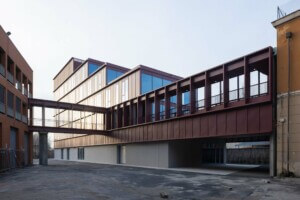The preeminent American scholar of Italian Renaissance architecture, James Ackerman passed away on December 31. A native of San Francisco, Ackerman trained at Yale and then the Institute of Fine Arts, New York University, where he studied under a number of prominent European émigrés, most notably Henri Focillon, Erwin Panofsky, and Richard Krautheimer, who eventually served as his dissertation advisor. Yet it was also his experience in the Second World War that shaped his scholarly trajectory. Stationed at the end of the war in northern Italy, he assisted in the transfer of state archives from the Certosa of Pavia as part of the Monuments, Fine Arts, and Archives Commission. This direct experience with one of the great buildings of the Renaissance helped lead the young scholar to focus on the architecture of this period.
After initially publishing two articles on Lombard architecture, including a now canonical study of the debates surrounding the design of Milan Cathedral, he undertook doctoral research in Florence, where he broke new ground through his exploration of the vast trove of architectural drawings held at the Uffizi. This interest in the media of architecture and modes of representation remained a constant throughout his career, and later expanded to even include architectural photography. His research eventually took him to Rome, where thanks to fellowships from the American Academy in Rome and the Fulbright Commission, he produced the first systematic investigation of the Cortile del Belvedere, the massive structure initiated by Pope Julius II to link the Vatican Palace to a nearby villa. Utilizing physical, graphic, archival, and textual evidence, his dissertation and subsequent book set the standard for monographic studies in the field.
Upon returning to the United States, Ackerman took up a position at the University of California, Berkeley, where he taught in both the nascent Art History department and the School of Architecture. In 1960, he left for Harvard where he eventually became the Arthur Kingsley Porter Professor of Fine Arts until his retirement in 1990. During his first decade there, Ackerman published monographs on Michelangelo and Palladio, which for the architectural community as whole, he is best remembered. Both still in print, they remain standards thanks to their lucid prose, rigorous scholarship, and synthetic approach. His Palladio (1966) and closely related Palladio’s Villas (1967) also heralded a shift in his scholarship toward a more social, political, and economic interpretation of architecture inspired in part by younger scholars, especially Manfredo Tafuri.
While the work of Andrea Palladio continued to captivate Ackerman, as seen both in his later publications and his long involvement with the Palladio Center in Vicenza, from the 1970s onward his interests grew increasingly broader and led to studies on Renaissance art and science, the villa as typology, and a number of other topics. Indeed, like his mentor Krautheimer (who also died at 97), Ackerman remained productive and academically curious until the very end, publishing just this last year the book Origins, Invention, Revision with essays on subjects as diverse as the early history of sketching, Frank Gehry, and Indian architecture.
Yet James Ackerman will be remembered for much more than just his prodigious academic output. For over the last half century, he has been the heart and magisterial voice of the discipline of Renaissance architectural history. As a devoted teacher, he stimulated many young architects and shepherded numerous leading figures into the field. He also actively sought to engage the wider public through his educational films Looking for Renaissance Rome (1976) and Palladio the Architect and His Influence in America (1980). Among his many honors, Ackerman was the first architectural historian to be the recipient of the prestigious Balzan Prize. With a portion of the award, he generously established the annual James Ackerman Prize for the History of Architecture, which has enabled the publication of books by emerging scholars across the discipline of architectural history. This commitment to the field and support for young academics was a hallmark of his career. He was also dedicated to a number of institutions, notably serving as editor of Art Bulletin and as a long-time trustee of the American Academy in Rome.
James Ackerman was both the last link to a now lost world of academia and a beacon guiding generations of scholars and architects forward in their engagement with Renaissance architecture. For his insightful research, pellucid writing, and dedicated teaching, as well as his service, outreach, and generosity, he set an academic standard for all to emulate.










